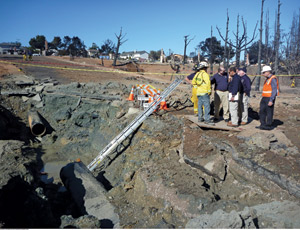While Pacific Gas and Electric prepares to explain to the California Public Utilities Commission at a March 24 hearing why it didn’t supply all its records for pressure tests of natural gas pipelines in high-consequence areas (HCA) as requested, other federal entities and elected representatives are getting more involved in the gas pressure spike controversy.

PG&E failed to satisfy CPUC’s terms under a March 15 deadline to provide data on its pipeline system. The utility says it supplied records for pressure tests or historical operating pressure for more than 90% of its 1,805 miles of natural gas transmission pipelines in HCAs. The CPUC shot back that it’s the “historical operating pressure” records that violate its demand.
CPUC directed PG&E on Jan. 3 to undertake urgent National Transportation Safety Board (NTSB) safety recommendations following the Sept. 9, 2010, San Bruno explosion. PG&E says it started right away in reviewing its records and on March 5 moved “tens of thousands of boxes” of documents to the Cow Palace arena in South San Francisco, assigning hundreds of employees and contractors to sift through piles.
A day after the deadline, Paul Clanon, executive director of the CPUC, sent a letter to Christopher Johns, PG&E president, telling the utility that the commission didn’t find “traceable, verifiable and complete records” that were required in the first place.
In PG&E’s 154-page report on Maximum Allowable Operating Pressure (MAOP) validation, a paragraph on page seven reads: “PG&E understands the intent to be to identify reliable records confirming the performance of a pressure test or the determination of MAOP based on the historical high operating pressure.”
“PG&E has no legitimate or good-faith basis for the conclusion quoted in the report,” writes Clanon. “As you well know, the whole purpose of the NTSB’s urgent safety recommendations, and for the commission’s directive to PG&E, was to find, to the extent possible, a basis for setting MAOP by means other than the grandfathering method described in PG&E’s response.”
PG&E will tell its side of the story at the hearing. Penalties and fines for not complying range from $20,000 per day for a single violation up to $1 million.
PG&E was put on the defensive following the blast that killed eight people and destroyed 38 homes.
NTSB’s January recommendations were based on its findings that PG&E’s actual installed pipe in Line 132, the line in San Bruno that ruptured, was not consistent with its as-built drawings. Utility drawings showed seamless pipe; investigators founds welded sections.
Overall, the CPUC says PG&E “appears to have attempted merely to justify the practice of setting MAOP for pre-1970 pipelines based entirely on historical high operating pressure.” The San Bruno pipeline was installed in 1956.
“I can understand some of the CPUC’s perspective though I don’t speak for them,” says Richard Kuprewicz, a pipeline safety consultant in Redmond, Wash. “I’ve seen a lot of pipeline operations in my almost 40 years and certain records or information [don’t] get lost, missing, misplaced or destroyed no matter how old …. The CPUC or the public [may] decide the operator has lost control of their operations and I hope we don’t get to that point.”
PG&E told the CPUC that it would continue to search for the missing as-built drawings. The utility also presented an in-line inspection and field-test plan with “smart pigs” and new camera technologies, as well as additional pressure testing and pipeline replacement.
Senators Dianne Feinstein and Barbara Boxer (both D-Calif.) asked the federal Pipeline and Hazardous Materials Safety Administration to close a loophole allowing utilities to not report most instances in which a pipeline is operated above the MAOP.
The senators told Cynthia Quarterman, PHMSA administrator, that even though federal law requires each operator of a transmission pipeline facility to submit a “written report on any condition that is a hazard to life, property or the environment,” regulations only require pipeline operators to report accidental cases in which the MAOP is exceeded if the operators are unable to correct the malfunction within five days.
“Nowhere do we find any obligation to report intentional pressure spikes over the MAOP,” write the senators, who add that they found mention of this loophole while reviewing regulations that could prevent another San Bruno event.



Post a comment to this article
Report Abusive Comment